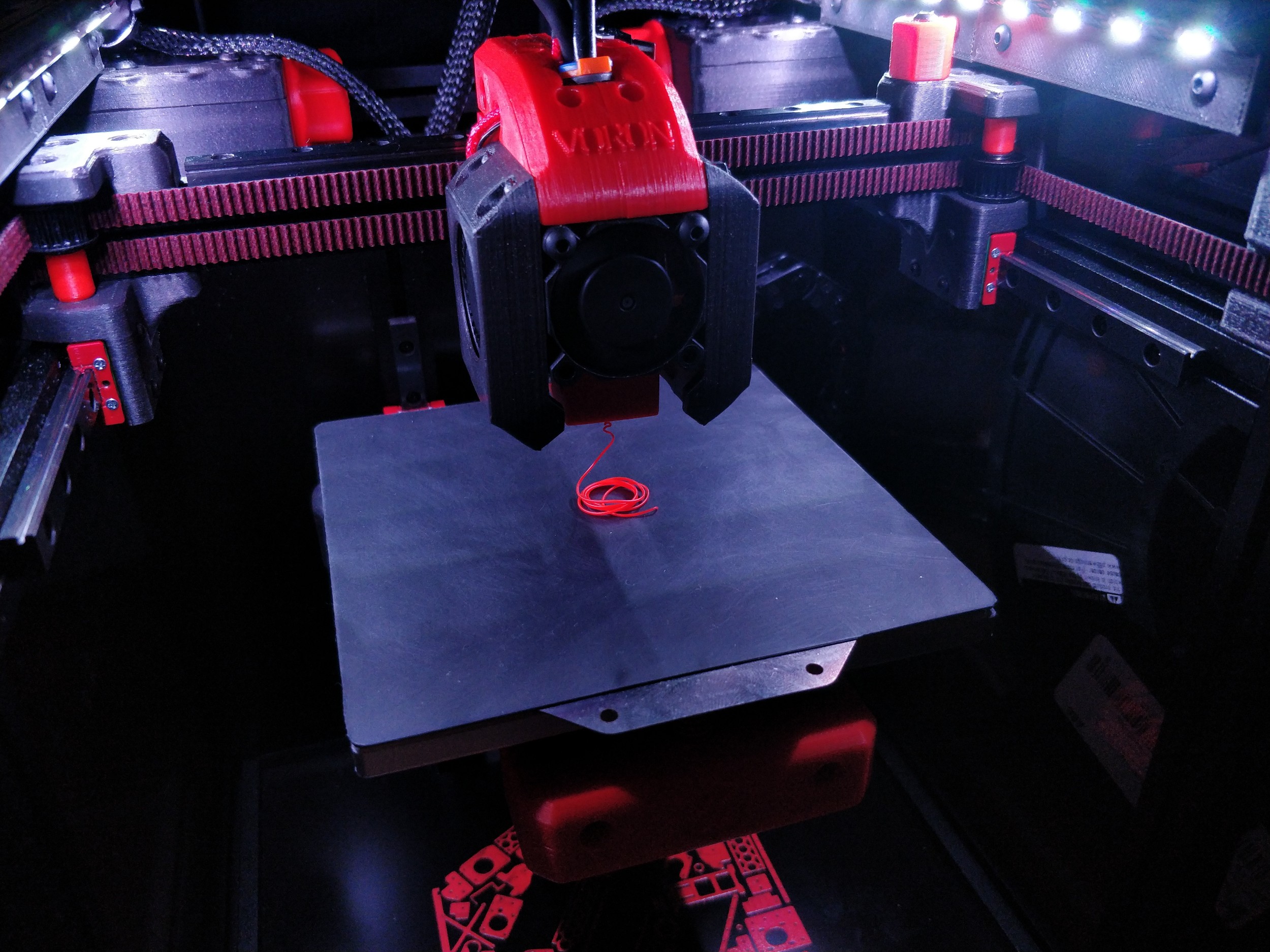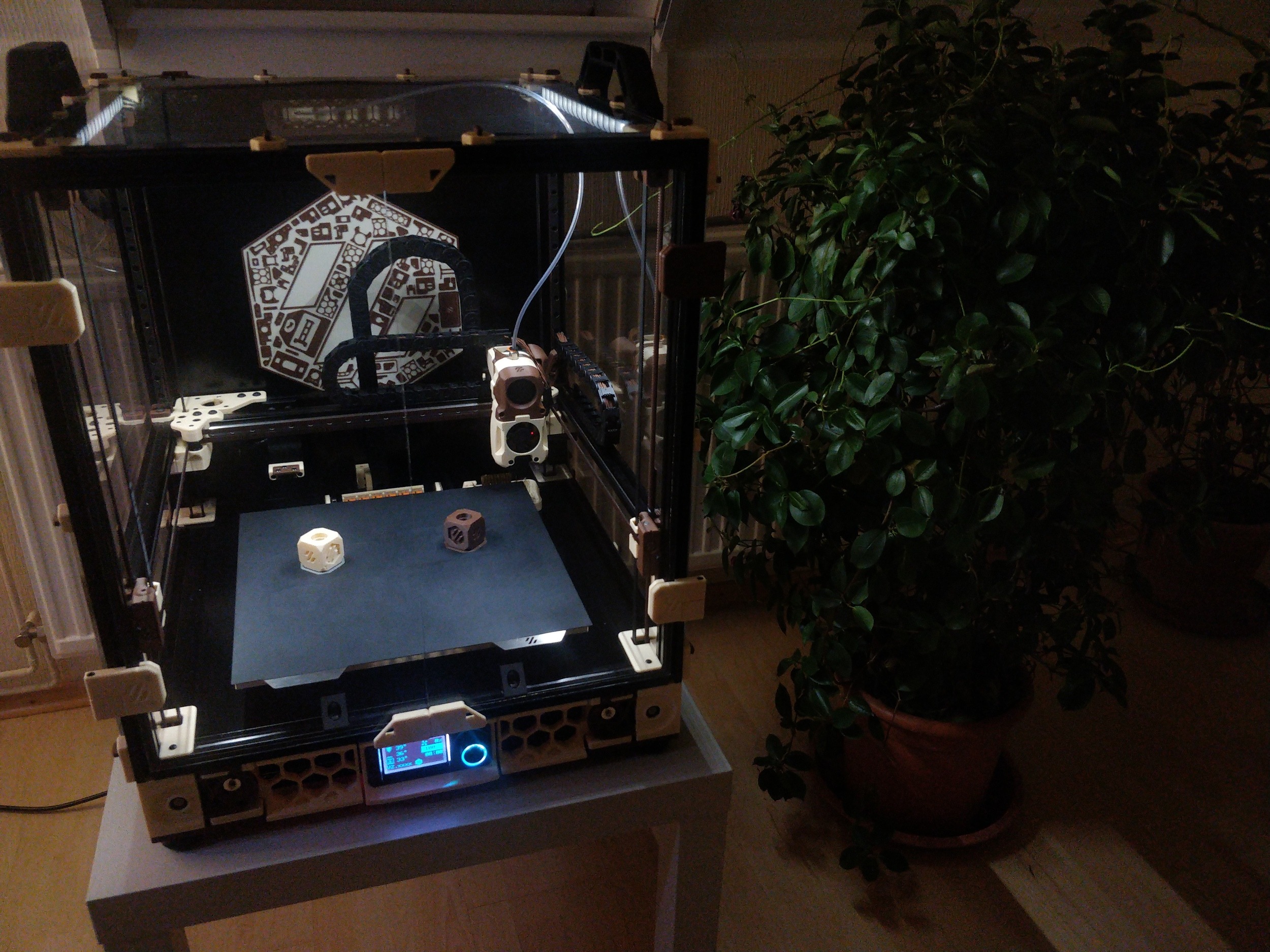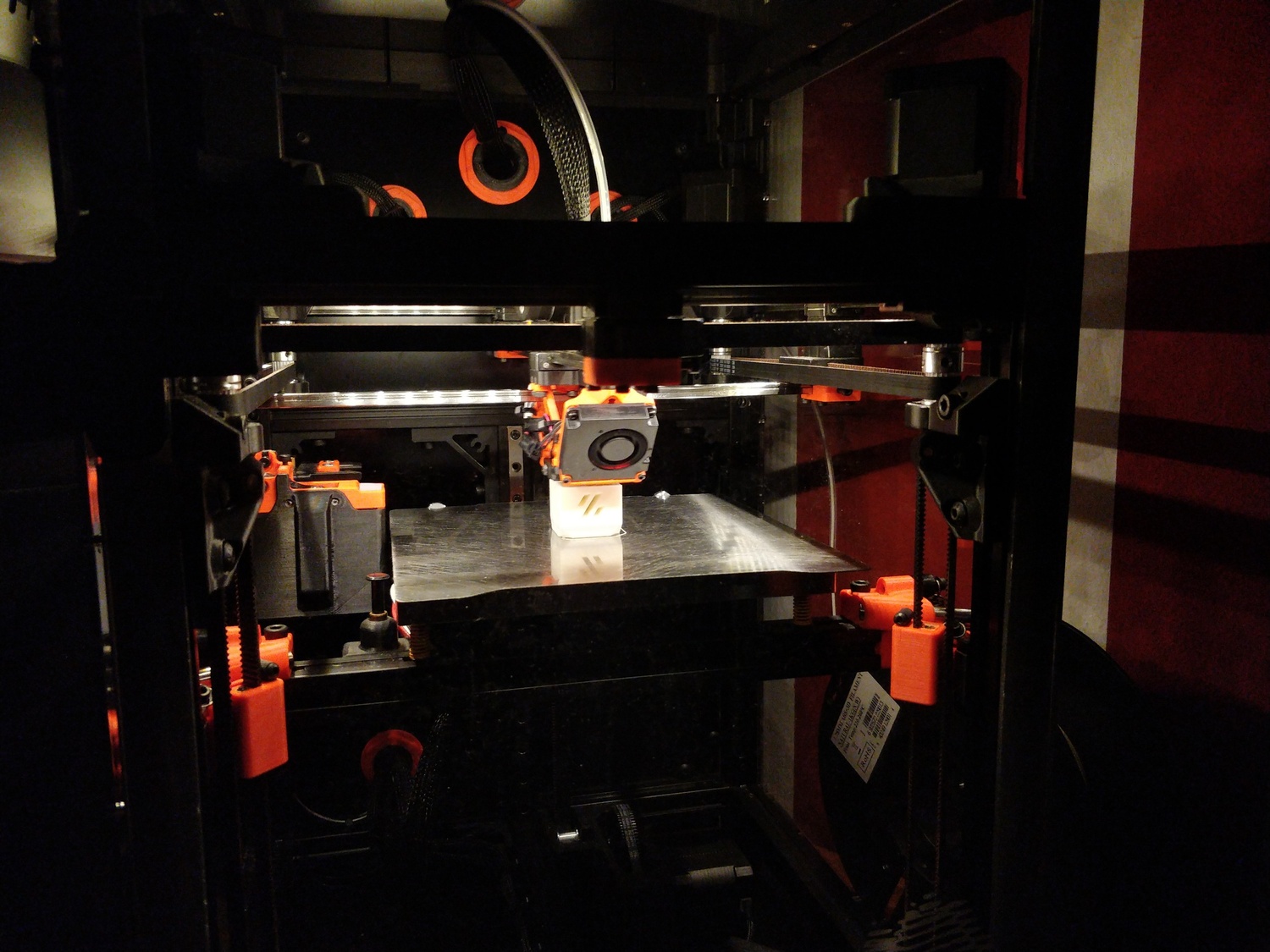This repository contains many of my 3D printing-related things including slicer and firmware configuration. Unless explicitly stated otherwise, the contents of this repository are licensed under the terms of the GPLv3.
Here is a list of my DIY 3D printer builds:
My first self-sourced 3D printer developed by the Voron Design team licensed under the GPL. Voron owners can request a serial number for their printer builds to mark the major milestone of completing a functioning printer (requirements are showing a working printer with proper cable management).
The V0 is a truly tiny printer encompassing a print volume of about 120mmx120mmx120mm. Typical for a Voron, the V0 has an enclosure and thus is ready to print more demanding filaments like ABS.
Originally built as a V0.0, this printer has later been updated to version V0.2.
Serial number: V0.378
After having made bad experiences with a poor quality frame on the V0.0, I decided to replace it entirely with one made by LDO. Opting for red extrusions since my primary filament would only come in black allowed this build to still have some color. I've also decided reach into the LDO box of V0 candy in few more places, replacing the stock bed carriage with a Kirigami bed and a nice stainless steel linear rail kit. Generic LED strips used for chamber lighting have been replaced by Rainbow on a Matchstick PCBs. The old AC heat bed has been retained as one of the handful of components surviving from the V0.0.
Really, the V0.2 upgrade has similarities with the Ship of Theseus thought experiment.
Filament used: 3DO ASA Carbon Black (base), eSUN ABS+ Grey (accent)
- Kirigami bed, LDO version
- LDO Picobilical PCB
- Rainbow on a Matchstick
- keystone rear skirt
- MGN9C X carriage with heatset inserts
- DIN rail mount
- PSU mounting plate (first time designing my own printer mod)
This is the first incantation of the V0 build.
This V0.0 used stock components throughout, including the OMC V0 stepper motor kit and CNA (RDBB) MGN7 linear rails. The hotend is a Trianglelab Dragon Standard Flow. The bedheater is specifically made for the V0 bed (custom fermiolabs) and I had to replace the stock GDStime part cooling fans with ones from Delta due to reliability issues. I also opted to not use the stock AC inlet solution instead chose a chassis-mount fused socket.
Filament used: KVP ABS Stellar Black (base), KVP ABS Voron Red (accent)
- rear skirt IEC inlet
- bed Wago mounts
- one part skirts
- LED strip mounts
- honeycomb backpack divider
- reverse bowden mount
- display
After completing the V0.0 build I began working on another printer in the Voron lineup: the V2. This is a significantly bigger machine with a print volume of about 300mmx300mmx270mm (in fact, you can put all of the V0 inside of the V2). The larger size affords packing the machine with more quality of life features including automatic bed probing, a purge bucket, and Z offset calibration.
One of the special features of this build is the use of the classical Noctua "poop-stain and creme" color scheme.
Serial number: V2.2828
The V2 build deviates from the stock recommended parts in more places than the V0.0 did: The stepper motors are provided from the LDO V2 kit. On top have I installed a BTT Octopus controller board and relays for separately controller supply power to the bed and controller board from the Raspberry Pi. A custom-sized heater sourced from fermiolabs is used here as well. Notably, the exhaust filter is not populated rather the hole is blanked off relying on the Nevermore Micro recirculating filter for air cleanup. The toolhead also incorporates a number of changes. Beginning with the Galileo planetary extruder replacing the Clockwork as well as improved part cooling using a 5015 blower fan and optimized ducts.
Filament used: Ampertec ABS skin (base), eSUN ABS+ brown (accent)
Finding the right filament matching the chosen colorscheme was a bit of a challenge. Noctua's classic colorscheme is Pantone PQ-483C (brown) and Pantone PQ-2309C (beige) as found in this Reddit thread. Matching the beige is especially tough since most filament ranges' beige/skin colors are more redish. People in the US have it easy as the high quality Paramount ABS skin (fair complexion) filament is very close to the Noctua tone (as discovered by Accurazine). Unfortunately, this filament is not available in the EU requiring me to hunt for new filament. I then stumbled upon the Ampertec ABS skin filament only sold in Germany and it matches Noctua's beige pretty closely as well.
The brown is easier to match. Here I followed Accurazine's lead: ABS+ brown from eSUN.
- 270 degree door hinges
- Nevermore Micro V5 air filter
- Afterburner 5015 part cooling mod and Warbird optimized duct
- slim front idler
- bed Wago mounts
- closed off exhaust grill
- skirt fan screw mounts
- Galileo Clockwork extruder
- Klicky detachable Z probe
- pins mod (replacing screws holding bearings in the belt path with pins)
- purge bucket
- spherical bearing Z joints
- beefed up Z drive tensioning
- sturdy top handles
- LED strip mounts
- parts from other Voron printers:
- Trident display and DIN rail mounts
- V2.2 panel and Wago frame mounting
I'm always on the lookout for interesting printer designs/kinematics and my eyes fell on the cross gantry concept (most notably used in the Ultimaker 3D printers) instead of yet another CoreXY build. The drawbacks of the design, like higher costs due to more complex electronics and more motion components and less space efficiency, are countered by the potential for reaching higher speeds. This space hasn't been explored as much as CoreXY. The most advanced designs seem to be released by Annex Engineering. My choice fell on the Annex K3 which tries to increase space efficiency as much a possible as I'm used to from my previous CoreXY builds.
The K3 is compact (for cross gantry printers anyway) and centered around a 180x180mm Prusa Mini-style bed. The ultra lightweight gantry coupled to four stepper motors gives this printer ludicrous speed potential. A big drawback for me compared to the Vorons is the more restrictive licensing of the Annex designs.
At the time of the build, the K3 was still in open beta having only a pseudo-CAD available requiring a proprietary viewer that is not available on Linux. There was no manual and the fastener section in the BOM wasn't finalized. That being said, the build went more smoothly than initially thought with the help of a rough assembly order from the Annex Discord. The build relies more heavily on custom-made components, specifically the enclosure uses quite a few laser-cut/milled parts. Luckily, I was able to join a local group buy that helped with sourcing enclosure panels.
Serial number: there are no serial numbers for Annex printers, sadly.
With this build I'm trying out the NF Crazy (Slice Mosquito clone) hotend with a Bondtech CHT nozzle for the first time and I'm liking it so far. However, more notable is the use of the Double Folder Ascender extruder featuring worm gears. This has been on my list of things to try out for a while. The worm gears give the extruder interesting Pressure Advance properties. However, it is quite a bit harder to source than the alternative Sherpa Mini.
Electronics follow the stock K3 build. It uses a frame thermistor in order to enable frame expansion compensation
Filament used: Prusament ASA Jet Black (base), and Prusa Orange (accent)
With the K3 being still in beta at the time of build and thus no released CAD, the number of modifications available for it was rather limited. However the stock build seems quite complete already making certain mods not really necessary. One mod I installed was the beefed up version of the Double Folded Ascender extruder released by StrikEagleCC.


